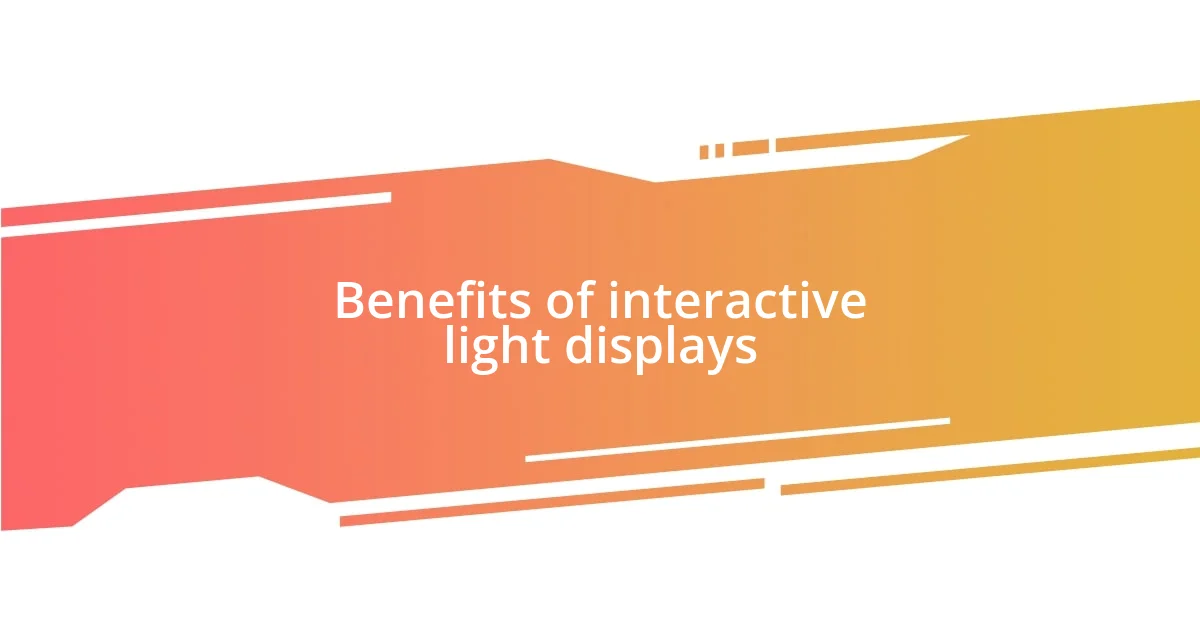Key takeaways:
- Interactive light displays blend technology and art, creating immersive experiences that encourage viewer engagement and emotional connections.
- Benefits include fostering community through shared experiences, enhancing learning by making complex concepts tangible, and evoking powerful emotions that create lasting memories.
- The future of interactive displays promises personalized and adaptive experiences, transforming public spaces into collaborative canvases that strengthen community bonds.

Understanding interactive light displays
Interactive light displays are fascinating creations that blend technology and artistry in a vibrant dance of colors and forms. I remember the first time I saw one at a festival; it felt like stepping into a dream where the environment changed around me with every movement. Isn’t it amazing how lights can evoke emotions and memories, transforming mere spaces into immersive experiences?
At their core, these displays respond to human actions, whether it’s a touch, movement, or sound. I often find myself mesmerized by how these installations can draw people in, encouraging them to engage and interact. Have you ever stood in front of a light display, feeling the urge to reach out and influence what you see? The magic lies in that connection, where the viewer becomes an integral part of the artwork, creating a unique moment that’s never repeated.
The technology behind interactive light displays can range from simple sensors to complex algorithms. I recall once being amazed by a display that seemed to react to the crowd’s energy—it pulsed and changed with the collective vibe. It leads me to wonder: how might these interactive experiences continue to evolve with advancements in technology? The potential is limitless, and the prospect of creating even more profound connections through light is truly exhilarating.

Benefits of interactive light displays
Interactive light displays offer a plethora of benefits that extend beyond mere visual appeal. One of my favorite aspects is how they foster a sense of community. I remember attending an art installation where everyone was encouraged to step forward and influence the lights. The excitement in the air was palpable as strangers became friends, united by their experience of creation. Isn’t it incredible how a simple interaction with light can break down barriers and ignite conversations?
Another remarkable benefit is their ability to enhance learning experiences. I once visited a science museum where the children were able to interact with a light display that illustrated basic physics concepts. Watching them laugh, play, and learn simultaneously was heartwarming. These displays can transform education into something tangible, making complex ideas more approachable and engaging for all ages.
Additionally, the emotional impact of interactive light displays cannot be overstated. I recall standing beneath a canopy of lights that changed with my movements, and it felt as though they were echoing my emotions. This dynamic relationship can create lasting memories that resonate with viewers long after they’ve left the installation. By engaging multiple senses, these displays can evoke feelings of joy, wonder, or even nostalgia, enriching our everyday experiences in unexpected ways.
| Benefit | Description |
|---|---|
| Fosters Community | Encourages interaction and connection among people. |
| Enhances Learning | Transforms complex concepts into engaging learning experiences. |
| Emotional Engagement | Creates lasting memories and evokes strong emotions. |

Key technologies behind light displays
The technologies that power interactive light displays are quite remarkable and serve as the backbone of these dynamic experiences. From my perspective, some of the most cutting-edge innovations employed include:
- LED lighting: Utilizing energy-efficient diodes not only increases brightness but also enhances color spectrum range.
- Sensors: Motion, touch, or sound sensors allow displays to react to human interaction, creating a personalized experience.
- Microcontrollers: These tiny computers process data from sensors and control the light patterns, making real-time transformations possible.
- Software algorithms: These complex programs can analyze inputs to produce engaging visual effects, adapting to the unique environment or audience.
I recall participating in a pop-up event where the entire space was illuminated by LED panels that changed colors with simple hand gestures. That evening, I felt a profound connection with the technology; it was as if the lights had a personality, responding playfully to our movements. This experience truly highlighted the potential of merging creativity with technology. It’s fascinating how the underpinning technologies not only drive the functionality of these displays but also amplify the emotional resonance of our interactions.

Designing engaging light display experiences
Designing engaging light display experiences requires a delicate balance of creativity and technology. During a festival I attended, a team of artists transformed a mundane outdoor area into a luminous wonderland with thoughtfully choreographed light patterns responding to live music. The atmosphere was electric, as the synchronization of light and sound ignited a collective energy among participants. Have you ever felt such a powerful connection between art and technology?
An essential factor in this design process is considering the viewer’s perspective. I remember wandering through an interactive installation where stepping on specific tiles activated different colors and shapes. It was fascinating to watch the delight on people’s faces as they discovered their ability to influence the environment. This playful engagement not only captivates but also fosters a deeper connection between individuals and the display. How important do you think it is to empower viewers in creating their own experiences?
Moreover, the setting plays a crucial role in crafting unique light displays. In one stunning experience, I found myself under a bridge adorned with ethereal projections that danced along the structures in response to the river’s reflections. It was mesmerizing to see how the environment was woven into the design, amplifying the beauty of the light display. I believe that when designers consider their surroundings, they can create moments that resonate emotionally, leaving viewers in awe. Isn’t it inspiring how a simple space can be transformed into an extraordinary experience through thoughtful design?

Popular trends in light displays
When I think about popular trends in light displays, one that stands out is the rise of immersive experiences. I attended an art exhibition where attendees were completely surrounded by projections that seemed to breathe with the music. It felt like stepping into a living painting, where every flicker of light told a different story. Have you ever found yourself lost in a moment like that, where the boundaries between art and reality blur?
Another trend I can’t ignore is the increasing use of sustainable practices in light displays. I remember visiting a festival that showcased installations powered by solar energy and energy-efficient materials. It was refreshing to see how beauty and responsibility could coexist in such a vibrant way. This approach not only highlights the importance of environmental consciousness but also adds a layer of thoughtfulness to the overall experience. How does sustainability resonate with you when it comes to enjoying technology and art?
Then there’s the innovative use of augmented reality (AR). At a tech fair, I encountered a light display that combined real-world elements with dynamic AR visuals. I could point my device at a sculpture and watch as colors exploded and patterns shifted right before my eyes. This interaction created a sense of wonder that felt almost magical. I find myself wondering, how do these technological integrations impact our perception of reality? There’s something deeply exciting about the future of interactive displays, and I believe we’re only at the beginning of this incredible journey.

Case studies of successful installations
One standout case study that comes to mind is an installation at the annual Festival of Lights in Berlin. I witnessed a façade of an old cathedral transformed into an animated light show that narrated a story through shifting colors and intricate designs. Each cycle told a different tale, and I remember the collective gasps from the audience as they connected with each scene. How powerful is it to see a piece of history come alive in such a vibrant way?
Another remarkable example is the interactive light mural created in a community park in my hometown. Local artists invited residents to participate in the design process, allowing them to submit ideas online before the installation. This sense of ownership sparked a deep appreciation, with families returning nightly to re-experience the evolving display. It made me reflect on how a project can foster community spirit—do you think collaborating in creative projects amplifies their impact?
Lastly, I’m particularly enchanted by the installation at a prominent airport that uses light displays to guide travelers. When I first encountered it, I was struck by how the colors changed to indicate different flight statuses. Not only did it serve a functional purpose, but it also transformed an often stressful experience into something calming. I ponder the effectiveness of design that marries utility with art—can you recall a moment when design helped ease a hectic day?

Future of interactive light displays
As I look to the future of interactive light displays, I can’t help but feel a wave of excitement about their potential to engage all our senses. Imagine walking into a space where the light and sound are not just background elements, but integral parts of an experience that responds to your movements or emotions. I think about concerts I attended where lights synchronized perfectly with the music, creating an atmosphere that felt alive. Will we see more of these interactive experiences that can adapt to our moods?
The evolution of technology also brings with it exciting prospects for personalized light displays. I remember a time I was at a friend’s wedding with a stunning light setup that reacted to the guests’ laughter and interactions. Each time someone erupted in joy, the lights flared brighter, almost like they were celebrating with us. This concept of personalization could extend even further, perhaps allowing displays to change based on individual preferences or memories. How delightful would it be to have light experiences that truly resonate with our unique stories?
On a broader level, as communities begin to embrace interactive light displays, I envision public spaces transforming into collaborative canvases. Recently, I walked through a tech-inspired art installation in my city where pedestrian movements triggered colors and patterns on street-level displays. It made me feel part of something bigger, connecting with strangers in a shared experience. I ask myself, how can we use these technologies to foster a sense of belonging and community in our urban environments? The future certainly feels bright, filled with opportunities to explore our relationships with art, technology, and each other.















